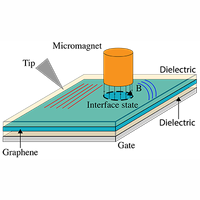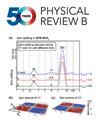二维电子气体中等离子体波的巨谐振偏斜散射
IF 3.7
2区 物理与天体物理
Q1 Physics and Astronomy
引用次数: 0
摘要
杂质的电子偏斜散射是铁磁纳米结构中反常霍尔效应背后的主要机制之一。在电子动力学受自旋-1/2 迪拉克方程支配的拓扑绝缘体表面,这种效应尤为强烈。受最近发现的流体力学与自旋-1 Dirac 方程之间映射的启发,我们考虑了石墨烯中由相邻圆形微磁体产生的非均匀磁场激发的等离子体波--传播电荷密度振荡--的散射。计算得出的散射振幅不仅表现出巨大的不对称性(或偏斜性),而且如果传入波的频率与环绕微磁体的手性陷波模式的频率相匹配,则散射振幅只在一个方向上共振增强。此外,如果传入等离子体波的频率比拉莫尔频率大几倍,那么其正向散射的角度分布与拓扑绝缘体表面的狄拉克电子对磁性杂质的散射几乎没有区别。这种微米尺度的装置可以直接研究以前在电子系统中无法获得的单个偏斜散射事件。本文章由计算机程序翻译,如有差异,请以英文原文为准。

Giant resonant skew scattering of plasma waves in a two-dimensional electron gas
Electron skew scattering by impurities is one of the major mechanisms behind the anomalous Hall effect in ferromagnetic nanostructures. It is particularly strong at the surface of topological insulators where electron dynamics is governed by the spin-1/2 Dirac equation. Motivated by recently discovered mappings between hydrodynamics and the spin-1 Dirac equation, we consider the scattering of plasma waves—propagating charge-density oscillations—excited in graphene off a nonuniform magnetic field created by an adjacent circular micromagnet. The calculated scattering amplitude not only exhibits a giant asymmetry, or skewness, but it is resonantly enhanced if the frequency of the incoming wave matches the frequency of the chiral trapped mode circulating the micromagnet in only one direction. Furthermore, if the frequency of the incoming plasma wave is a few times larger than the Larmor frequency, the angular distribution of its forward scattering is almost indistinguishable from that of a Dirac electron at the surface of a topological insulator scattering off a magnetic impurity. The micrometer scale of the proposed setup enables direct investigations of individual skew scattering events previously inaccessible in electronic systems.
求助全文
通过发布文献求助,成功后即可免费获取论文全文。
去求助
来源期刊

Physical Review B
物理-物理:凝聚态物理
CiteScore
6.70
自引率
32.40%
发文量
0
审稿时长
3.0 months
期刊介绍:
Physical Review B (PRB) is the world’s largest dedicated physics journal, publishing approximately 100 new, high-quality papers each week. The most highly cited journal in condensed matter physics, PRB provides outstanding depth and breadth of coverage, combined with unrivaled context and background for ongoing research by scientists worldwide.
PRB covers the full range of condensed matter, materials physics, and related subfields, including:
-Structure and phase transitions
-Ferroelectrics and multiferroics
-Disordered systems and alloys
-Magnetism
-Superconductivity
-Electronic structure, photonics, and metamaterials
-Semiconductors and mesoscopic systems
-Surfaces, nanoscience, and two-dimensional materials
-Topological states of matter
 求助内容:
求助内容: 应助结果提醒方式:
应助结果提醒方式:


